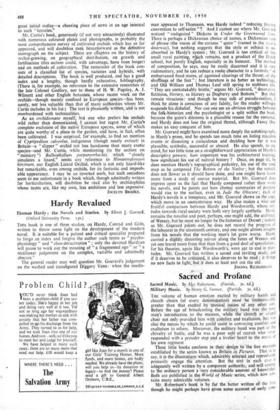Sacred and Profane
THE volume of human emotion excited by military bands and church choirs (of every dericimibatioti) must"- be imrifeasurably greater than that excited by musical noises of any other sort. Before the age of broadcasting the military band was the poor man's introduction to the masters, while the church or chapel choir not only provided him with comfort and exaltation, but was also the means by which he could assist in conveying comfOlt and exaltation to others. MoreoVer, the military band was part of the chivalry of battle, and he was a poor soft of recruit who never responded with a prouder step and a livelier heart to the music of his own regiment These little books conform in :their design- -to the fine example established by the series known as Britain in Pictures. That is to say, it is the illustrations which, admirably selected and reproduced, primarily engage the attention. But the text in each case is adequately well written by a competent authority, and mill convey to the ordinary person a very considerable -amount of knowledge Both are published in the World of Music series, which tidw co0. tains many admirable volumes. Mr. 'Robertson's book is by tar the better written ot the t", though he might perhaps have given some account of early sYna- gogue music and of the Perso-Arabian scales investigated by Breslaur. Any account of sacred music involves a study of the transition from the melodic to the polyphonal style of composition, and here (though I doubt whether Mr. Robertson would allow it) the Lutheran contribution to church music is probably supreme. Mr. Robertson traces the slob; emergence of polyphony, based upon the addition of supplementary noles to the chant, with clarity and erudition. He stresses the ingenious floridity of the baroque Masses of the sixteenth century, when whole orchestras invaded the church and organs thundered out a roof-quaking diapason below the trumpets and the trombones. And so the Mass became, in those resounding pompous days, not so much an office as a performance. Mr. Robertson follows the music of the Mass up to modern times, and he finds in Stravinsky and Rubbra something like a return to the reverence and austerity of a true liturgical style.
Dr. Farmer's essay on military music is well contrived and interesting. His book contains a reproduction of that superb mezzo- tint of the black tambourinist of the Coldstream Guards, shaking and striking his tambourine under the doom-laden sooty clouds that were always dear to the painters and engravers of the eighteenth century: a most astonishing piece of work. The history of the military band is traced from the Renaissance, when it became a service institution, to the present day. (Surely Dr. Farmer might have begun with Jericho. when the horns pitched dpon the harmonics of the town walls.) Dr. Farmer shows how the -intro- duction of the oboe in the seventeenth century—an instrument which gave precision and acuity to the higher notes, usually those of the tune—marked the beginnings of the modern band. A curious error should be noted in the descriptions of three of the pictures ; the coronation of James II did not occur (as here stated) in 1678, for he did not come to the throne until 1685. Then, moving away from the barracks or the battle, military music took its place in ceremonials and entertained the citizens and their wives. In the nineteenth century the military band was the parent of new devices and instruments, some of which eventually found their way into the orchestra proper. One might perhaps have wished for a little more information on the subject of scoring ; and something might have been said also, I think, about the occasional and alternative use of strings in military bands.
Both books are excellent, but the shiny jackets, printed in Holland, are unworthy of them, and are discrepant with the admirable taste and the extremely skilful choice of pictures which distinguish the



















































 Previous page
Previous page